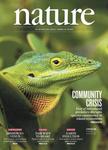作者:Khatib, Muhammad; Zhao, Eric Tianjiao; Wei, Shiyuan; Park, Jaeho; Abramson, Alex; Bishop, Estelle Spear; Thomas, Anne-Laure; Chen, Chih-Hsin; Emengo, Pamela; Xu, Chengyi; Hamnett, Ryan; Root, Samuel E.; Yuan, Lei; Wurdack, Matthias J.; Zaluska, Tomasz; Lee, Yeongjun; Parkatzidis, Kostas; Yu, Weilai; Chakhtoura, Dorine; Kim, Kyun Kyu; Zhong, Donglai; Nishio, Yuya; Zhao, Chuanzhen; Wu, Can; Jiang, Yuanwen; Zhang, Anqi; Li, Jinxing; Wang, Weichen; Salimi-Jazi, Fereshteh; Rafeeqi, Talha A.; Hemed, Nofar Mintz; Tok, Jeffrey B. -H.; Qian, Xiang; Chen, Xiaoke; Kaltschmidt, Julia A.; Dunn, James C. Y.; Bao, Zhenan
作者单位:Stanford University; University System of Georgia; Georgia Institute of Technology; University System of Georgia; Georgia Institute of Technology; Emory University; Stanford University; Stanford University; Stanford University; Stanford University; Stanford University; Stanford University; Michigan State University; Michigan State University; Stanford University; Stanford University; Stanford University
摘要:There is an increasing demand for multimodal sensing and stimulation bioelectronic fibres for both research and clinical applications1,2. However, existing fibres suffer from high rigidity, low component layout precision, limited functionality and low density of active components. These limitations arise from the challenge of integrating many components into one-dimensional fibre devices, especially owing to the incompatibility of conventional microfabrication methods (for example, photolithog...
作者:Miyashita, Tetsuto; Janvier, Philippe; Tietjen, Kristen; Berenguer, Felisa; Schoder, Sebastian; Marone, Federica; Gueriau, Pierre; Coates, Michael I.
作者单位:University of Ottawa; Museum National d'Histoire Naturelle (MNHN); University of Kansas; University of Kansas; Universite Paris Saclay; Centre National de la Recherche Scientifique (CNRS); Museum National d'Histoire Naturelle (MNHN); SOLEIL Synchrotron; Swiss Federal Institutes of Technology Domain; Paul Scherrer Institute; University of Lausanne; University of Chicago
摘要:The standard scenario for the origin of jawed vertebrates depicts a transition from benthic grazers to nektonic predators1, 2-3, facilitated by a suite of anatomical innovations, including elaborate sensory systems, a high-flow heart and the integration of jaw-opening muscles with the craniothoracic hinge4, 5, 6-7. However, the lamprey-like internal anatomy8, 9, 10, 11, 12-13 reconstructed for osteostracans, the sister group of jawed vertebrates, seem to lack these gnathostome traits, implying...
